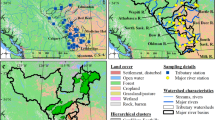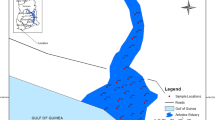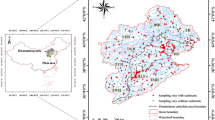Abstract
Mercury is a globally distributed pollutant that biomagnifies in aquatic food webs. In the United States, 3781 water bodies fail to meet criteria for safe fish consumption due to mercury bioaccumulation. In the risk assessment and management of these impairments (through the total maximum daily load program), an important step is evaluating the relationship between aqueous mercury and mercury in fish tissue. Often, this relationship is simplified to a bioaccumulation factor (BAF): the ratio of fish tissue mercury to aqueous mercury. This article evaluates the relationship between aqueous mercury and fish tissue mercury across a contamination gradient in the South and South Fork Shenandoah rivers of Virginia. The relationship was found to be nonlinear, with BAFs decreasing as the level of contamination increased. This means that protective water column mercury concentration targets established from site-specific BAFs will be overestimated in contaminated areas and will not be sufficiently protective. To avoid this over-prediction in the South and South Fork Shenandoah rivers, an empirical nonlinear Michaelis–Menten model was used to establish a protective water-quality target. Among other models and variables, the Michaelis–Menten model, relating total mercury in the water column to methylmercury in fish tissue, achieved the best empirical fit (r 2 = 0.9562). The resulting water-quality targets using this model were 3.8 and 3.2 ng/l for the South and South Fork Shenandoah rivers, respectively. These values are 2.1–2.5 times lower than the water-quality target developed using a site-specific BAF. These findings demonstrate the need to consider nonlinear BAF relationships in mercury-contaminated areas.








Similar content being viewed by others
References
Arizona Department of Environmental Quality, United States Environmental Protection Agency Region 9, and Tetra Tech, Inc. (1999) Total maximum daily load and implementation plan for mercury, Arivaca Lake, AZ. USEPA, Washington, DC
Atkeson TD, Axelrad DM, Pollman CD, Keeler GJ (2003) Integrating atmospheric mercury deposition with aquatic cycling in the Florida Everglades: an approach for conducting a total maximum daily load analysis for an atmospherically derived pollutant. Integrated Summary, Final Report. Florida Department of Environmental Protection, University of Michigan Air Quality Laboratory, and Tetra Tech Inc., Tallahassee, FL
Brumbaugh WG, Krabbenhoft DP, Helsel DR, Wiener JG, Echols KR (2001) A national pilot study of mercury contamination of aquatic ecosystems along multiple gradients: bioaccumulation in fish. Biological Science Report USGS/BRD/BSR-2001–0009. United States Geological Survey, Columbia, MO
Carter LJ (1977) Chemical plants leave unexpected legacy for two Virginia Rivers. Science 198:1015–1020
Choi SC, Chase T, Bartha R (1994a) Metabolic pathways leading to mercury methylation in Desulfovibrio desulfuricans LS. Appl Environ Microbiol 60(11):4072–4077
Choi SC, Chase T, Bartha R (1994b) Enzymatic catalysis of mercury methylation in Desulfovibrio desulfiricans LS. App Environ Microbiol 60(4):1342–1346
Clarkson TW (2002) The three modern faces of mercury. Environ Health Perspect 110:11–23
Colorado Department of Public Health, Environment (2003) Total maximum daily load for mercury in McPhee and Narraguinnep Reservoirs, Colorado. Water Quality Control Division, Colorado Department of Public Health and Environment, Denver, CO
Darnell J, Lodish H, Baltimore D (1990) Molecular cell biology. Scientific American Books, New York, NY
DeForest DK, Brix K, Adams W (2007) Assessing metal bioaccumulation in aquatic environments: the inverse relationship between bioaccumulation factors, trophic transfer factors and exposure concentration. Aquat Toxicol 84:236–246
Eggleston J (2009) Mercury loads in the South River and simulation of mercury total maximum daily loads (TMDLs) for the South River, South Fork Shenandoah River, and Shenandoah River—Shenandoah Valley, Virginia. United States Geological Survey Scientific Investigations Report 2009–5076. United States Geological Survey, Richmond, VA
Facemire C, Augspurger T, Bateman D, Brim M, Conzelmann P, Delchamps S et al (1995) Impacts of mercury contamination in the southeastern United States. Water Air Soil Pollut 80:923–926
Flanders JR, Turner RR, Morrison T, Jensen R, Pizzuto J, Skalak K et al (2010) Distribution, behavior, and transport of inorganic and methylmercury in a high gradient stream. Appl Geochem 25:1756–1769
Gilmour CC, Henry EA (1991) Mercury methylation in aquatic systems affected by acid deposition. Environ Pollut 71:131–169
Harada M (1995) Minamata disease: methylmercury poisoning in Japan caused by environmental pollution. Crit Rev Toxicol 25:1–24
Harris RC, Bodaly RA (1998) Temperature, growth and dietary effects on fish mercury dynamics in two Ontario lakes. Biogeochemistry 40:175–187
Hope B (2003) A basin-specific aquatic food web biomagnification model for estimation of mercury target levels. Environ Toxicol Chem 22:2525–2537
Kamman NC, Burgess NM, Driscoll CT, Simonin HA, Goodale W, Linehan J et al (2005) Mercury in freshwater fish of northeast North America – a geographic perspective based on fish tissue monitoring databases. Ecotoxicology 14:163–180
Knightes CD, Ambrose RB (2007) Evaluating regional predictive capacity of a process-based mercury exposure model, regional-mercury cycling model, applied to 91 Vermont and New Hampshire lakes and ponds, USA. Environ Toxicol Chem 26:807–815
Knightes CD, Sunderland EM, Barber MC, Johnston JM, Ambrose RB (2009) Application of ecosystem-scale fate and bioaccumulation models to predict fish mercury response times to changes in atmospheric deposition. Environ Toxicol Chem 28:881–893
Lawler, Matusky & Skelly Engineers (LMS) (1982) Engineering feasibility study of rehabilitating the South River and South Fork Shenandoah River, Volume II of II, Final Report. LMS, Pearl River, NY
Lawler, Matusky & Skelly Engineers (LMS) (1989) Reassessment of mercury in the South River and South Fork Shenandoah River. LMS, Pearl River, NY
Lineweaver H, Burk D (1934) The determination of enzyme dissociation constants. J Am Chem Soc 56:658–666
Luoma SN, Rainbow PS (2005) Why is metal bioaccumulation so variable? Biodynamics as a unifying concept. Environ Sci Technol 39:1921–1931
Mason RP, Reinfelder JR, Morel FMM (1995) Bioaccumulation of mercury and methylmercury. Water Air Soil Pollut 80:915–921
McGreer JC, Brix KV, Skeaff JM, DeForest DK, Brigham SI, Adams WJ et al (2003) Inverse relationship between bioconcentration factor and exposure concentration for metals: implications for hazard assessment of metals in the aquatic environment. Environ Toxicol Chem 22:1017–1037
Morel FMM, Kraepiel AML, Amyot M (1998) The chemical cycle and bioaccumulation of mercury. Annu Rev Ecol Syst 29:543–566
Oregon Department of Environmental Quality (2006) Willamette basin mercury TMDL, Chap. 3. Oregon Department of Environmental Quality, Portland, OR
Pak KR, Bartha R (1998) Mercury methylation and demethylation in anoxic lake sediments and by strictly anaerobic bacteria. Appl Environ Microbiol 64:1013–1017
Parsons (2005) TMDLs for mercury in fish tissue for coastal bays and gulf waters of Louisiana. Parsons, Austin, TX
Sorensen J, Glass G, Schmidt K, Huber J, Rapp G (1990) Airborne mercury deposition and watershed characteristics in relation to mercury concentrations in water, sediment, plankton and fish of eighty northern Minnesota lakes. Environ Sci Technol 24:1716–1727
Southworth GR, Peterson MJ, Bogle MA (2004) Bioaccumulation factors for mercury in stream fish. Environ Practice 6:135–143
State Water Control Board (1980) Mercury contamination of the South, South Fork Shenandoah, and Shenandoah Rivers, Basic Data Bulletin 47. State Water Control Board, Commonwealth of Virginia, Richmond, VA
State Water Control Board (2010) 9 VAC 25–260 Virginia water quality standards. State Water Control Board, Commonwealth of Virginia, Richmond, VA
United States Environmental Protection Agency (1991) Guidance for water quality-based decisions: The TMDL process. EPA 440/4–91-001. USEPA, Washington, DC
United States Environmental Protection Agency (1997) Mercury study report to Congress. Volume III: fate and transport of mercury in the environment. EPA-452/R-97–005. Office of Air Quality Planning and Standards and Office of Research and Development, USEPA, Washington, DC
United States Environmental Protection Agency (2001a) Water quality criterion for the protection of human health: methylmercury. EPA-823-R-01–001. Office of Science and Technology, Office of Water, USEPA, Washington, DC
United States Environmental Protection Agency (2001b) Total maximum daily load for total mercury in fish tissue residue in the middle and lower Savannah River watershed. Region 4, USEPA, Athens, GA
United States Environmental Protection Agency (2002) Method 1631, revision E: mercury in water by oxidation, purge and trap, and cold vapor atomic fluorescence spectrometry. EPA-821-R-02–019. Office of Water, USEPA, Washington, DC
United States Environmental Protection Agency (2003) Total maximum daily load for total mercury in fish tissue residue in Chattahoochee River. Region 4, USEPA, Athens, GA
United States Environmental Protection Agency (2004) Total maximum daily load for total mercury in fish tissue residue in the Canoochee River. Region 4, USEPA, Athens, GA
United States Environmental Protection Agency (2010a) National summary of impaired waters and TMDL information. Watershed Assessment, Tracking, and Environmental Results (WATERS) Information System. USEPA, Washington, DC. http://iaspub.epa.gov/waters10/attains_nation_cy.control?p_report_type=T. Accessed: December 21, 2010
United States Environmental Protection Agency (2010b) Guidance for implementing the January 2001 methylmercury water quality criterion. EPA 823-R-10–001. Office of Water, USEPA, Washington, DC
Virginia Department of Environmental Quality (2005) Standard operating procedures manual for the Department of Environmental Quality water quality monitoring and assessment program. Virginia Department of Environmental Quality, Richmond, VA
Virginia Department of Environmental Quality (2008a) 305(b)/303(d) Water quality assessment/integrated report. Virginia Department of Environmental Quality, Richmond, VA
Virginia Department of Environmental Quality (2008b) Fish tissue mercury in 2007: South River, South Fork Shenandoah River, and Shenandoah River. Virginia Department of Environmental Quality, Richmond, VA
Virginia Department of Environmental Quality (2009) Total maximum daily load development for mercury in the South River, South Fork Shenandoah River, and Shenandoah River. Virginia. Virginia Department of Environmental Quality, Richmond, VA
Watras CJ, Bloom NS (1992) Mercury and methylmercury in individual zooplankton: Implications for bioaccumulation. Limnol Oceanogr 37:1313–1318
Watras CJ, Back RC, Halvorsen S, Hudson RJM, Morrison KA, Wente SP (1998) Bioaccumulation of mercury in pelagic freshwater food webs. Sci Total Environ 219:183–208
Winfrey MR, Rudd JWM (1990) Environmental factors affecting the formation of methylmercury in low pH lakes. Environ Toxicol Chem 9:853–869
Author information
Authors and Affiliations
Corresponding author
Rights and permissions
About this article
Cite this article
Brent, R.N., Kain, D.G. Development of an Empirical Nonlinear Model for Mercury Bioaccumulation in the South and South Fork Shenandoah Rivers of Virginia. Arch Environ Contam Toxicol 61, 614–623 (2011). https://doi.org/10.1007/s00244-011-9664-0
Received:
Accepted:
Published:
Issue Date:
DOI: https://doi.org/10.1007/s00244-011-9664-0




